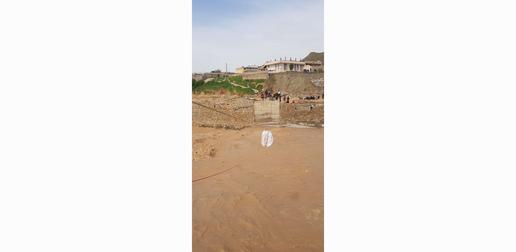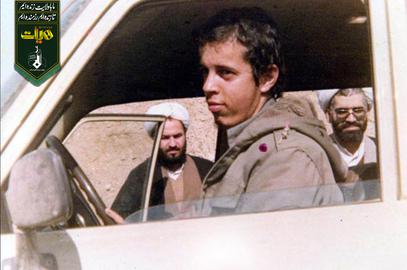Sometimes when people are faced with a disaster, they respond with incredible creativity and resourcefulness, doing what they can to ease pain and sorrow. And the recent floods in Iran have seen one group of volunteers do just that.
In Lorestan province in western Iran, a group of mountaineers came up with the idea of using a zip line and mountaineering equipment to rescue flood victims. The Hoof Adventure and Eco-Tourism Club went on to Telegram and other social media to let the public know that they were able and willing to help people who had been trapped in the recent heavy storms and the ensuing floods.
They said they were in a position to help people, the government and local relief workers by abseiling and rappelling — descending a vertical surface with a rope — to hard-to-reach locations. They also helped by Tyrolean traversing (crossing through free space between two high points on a rope), by making temporary hanging suspended bridges, and by using a zip line, a pulley suspended on a cable made of stainless steel and mounted on a slope.
Hossein Karamollahi, Abas Maleki, Reza Jam and Reza Ghochifar founded Hoof Adventure and Eco-Tourism Club — “hoof” means “excessive emotion, fear or excitement” in the Luri language, a regional Iranian language — a year ago, but they have been working together for years, since they set up the Kooch Mountaineering group in Khorramabad, the capital of the western province of Lorestan.
Iranian officials failed to issue flood warnings after heavy rains started in late March, despite the fact that they could have been predicted. At the time of the heaviest flooding, a group of tourists went missing on the trail to Shevi and Talleh Zang waterfalls. Shevi Waterfall is the biggest natural waterfall in the Middle East and a perennial tourist attraction. On that day, the tourists had no inkling about the torrential rains and the floods to come. When the locals realized they had lost contact with the group, the Hoof club, members of the Kooch group and Sepid Dasht Club mountain climbers set out for Shevi Waterfall to rescue the tourists. However, when they reached the waterfall, they received news that the sightseers had returned by another route and were safe.There were reports of other sightseeing groups losing their way too.
The Rapid Response Team
The floods continued, and the group decided to form a rapid response team, knowing that their mountain-climbing expertise, zip line and Tyrolean traverse would be put to good use. In one operation alone they succeeded in getting two and a half tons of food to villages surrounded by floods. They also rescued 40 people, one by one, who had been trapped.
Hossein Garab, a resident of Roodbar Kunani village, had left his home to sell his sheep but became trapped, along with a neighboring family. His sheep — he and his family’s only worldly possession — were carried away in the flood. He said they were surrounded by floodwaters for 72 hours without food or drinking water. They had worried they would not get out alive when the Hoof Club volunteers rescued them.
A local relief worker called Forood talked of how the rapid action group, local mountain climbers and army helicopters set up temporary bridges to villages surrounded by floods and delivered food, blankets and clothing to the villagers.
Hoof volunteers also succeeded in transporting workers from the local Water and Power Bureau, along with a welding machine and other necessary equipment, to the village of Paran Parviz so they could repair the village’s gas and electricity lines.
The group also organized a campaign to gather non-monetary donations from people to help people affected by the flood. Since there has widespread mistrust of the government, people were more inclined to trust a group like Hoof, and the campaign was well received.
Hoof also worked side by side with the army’s 65th Brigade and special airborne forces the Green Berets, which were trying to repair a pipe carrying drinking water to the village of Cham Mehr. The volunteers helped the army transport the replacement pipe and the equipment required to repair the village’s electrical system.
Experienced in Disaster Relief
Hoof volunteers have stepped in during previous times of disaster. Even before the group officially created its organization, it had helped out during the devastating Rudbar earthquake in northern Iran, and in rescue missions following plane crashes in Khorramabad and in the province of Chaharmahal and Bakhtiari.
In 2017, when a 7.3-magnitude earthquake hit Sarpol-e Zahab in the western province of Kermanshah, they spent 20 days in the devastated area, and helped relief workers to reach difficult-to-reach places.
“I know that in certain provinces like Khuzestan people were forewarned,” says Hossein Garab from the village of Roodbar Kunani in Lorestan. "But there was no forewarning or planning to deal with the heavy precipitation and flooding in Lorestan,” he said. “So the people were completely taken off guard and many were cut off and surrounded by water. The people in these villages use decrepit aerial lifts to cross the rivers and these lifts could turn into disasters at any moment.” According to him, the second round of floods destroyed around 90 percent of the bridges in Lorestan and people were stranded.
After collecting donations from people, the Hoof volunteers then decided to return to the heart of the flooded area, but the main roads between the cities of Pol-e Dokhtar and Khorramabad had been washed out and they did not have proper vehicles to travel the flooded side roads to help rescue people and offer relief. Eventually they found three adequate vehicles, loaded up the necessary equipment and set out for Pol-e Dokhtar with donations, accompanied by the province’s mountain climbing team and volunteers from the Kooch group.
Fear of Starvation
Immediately upon arrival, the group went to the headquarters of the local Red Crescent. The people there, fearful of starvation, had already pillaged the building. They then went to the city’s Revolutionary Guards’ headquarters.
“Perhaps if they had forewarned people they would not have been so gripped by fear,” says Hossein Garab. “In a hangar away from the flooded area, the Guards had set up tents to shelter people but, unfortunately, the number of tents were far fewer than the people who had lost their homes. I did not count them, but I think there were 50 or 60 tents and this was not enough.” According to him, most of the relief workers’ efforts were wasted because there wasn’t anywhere to coordinate jobs and relief work. “It was a waste of good energy because either their efforts were misdirected or they worked in parallel without knowing what the others were doing,” he said.
In the midst of the mayhem, Hoof volunteers were looking for a fixed base from which to operate. Eventually, with the help of the head of a mountaineering team from the province, they set up operations in a hall at the city’s Azad University. Immediately after, they set up groups to rescue people and help flood victims. Using a zip line, they evacuated the elderly and the sick from the flooded areas and linked the villages of Murani, Kian Abad and Kialeh.
On its Telegram channel, Hoof wrote that as long as the situation remains critical in Khorramabad, Shahivand, Mamulan, Masur, Koohdasht and other flooded areas, they would stay with the flood victims and would continue to help them to the best of their abilities.
Related Coverage:
No Trust in Government as Khuzestan Faces Devastating Floods, April 12, 2019
Zarif and Pompeo Exchange Insults and Accusations as Floods Continue, April 3, 2019
The Iran Floods and Ayatollah Khamenei’s Responsibilities, April 2, 2019
Iran’s Hurricane Katrina Moment, April 2, 2019
The Floods, the Foreign Conspiracy and Rouhani vs. the Guards, April 1, 2019
Iran Floods: What are the Government’s Legal Duties?, March 29, 2019
Rouhani Visits Devastated Areas as Floods Continue, March 28, 2019
Iran’s Budget for Religion 80 Times Higher Than Disaster Relief, March 28, 2019
As Environmentalists Perish in Prison..., March 26, 2019
Iran’s New Year Floods, March 25, 2019
visit the accountability section
In this section of Iran Wire, you can contact the officials and launch your campaign for various problems

































comments